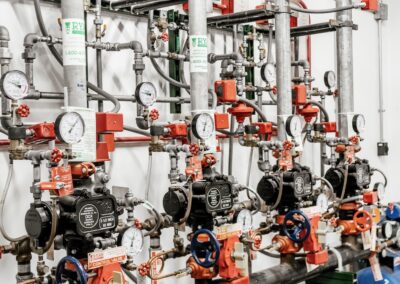Fire pumps play a critical role in water-based fire protection systems. When a building’s water supply doesn’t provide enough pressure, the fire pump steps in—boosting water flow so sprinklers, standpipes, and other suppression systems can do their job when it matters most.
Fire pumps are typically found in larger buildings or facilities where the municipal water pressure alone can’t meet system demand. They’re powered either by electric motors or diesel engines, each with its own maintenance and testing requirements. Electric pumps are common and low maintenance, while diesel pumps provide reliability in the event of a power outage.
How Fire Pumps Work
When sprinklers activate during a fire, system pressure drops. The fire pump automatically turns on to restore that pressure, ensuring a consistent flow of water throughout the system. This process happens almost instantly, allowing the sprinkler system to effectively suppress or control the fire until help arrives.
Fire pump systems include three main components:
- The pump – moves the water
- The driver – powers the pump (electric or diesel)
- The controller – monitors pressure and activates the system when needed
Regular Testing and Maintenance
Fire pumps are powerful, complex systems that require routine inspection and testing to stay reliable. Weekly or monthly tests verify pressure and system readiness, while annual flow testing confirms the pump performs to its design standards. For diesel-driven systems, yearly engine maintenance is also essential.
Professional inspections not only help maintain compliance with NFPA 20 but also give you peace of mind that your fire protection systems are ready when needed.
Have questions about your facility’s fire pump system? Contact us today to connect with one of our fire protection experts.
Want to learn more? Register for our upcoming virtual training October 23rd on Fire Pump Basics to dive deeper into how these systems operate and how to keep them performing at their best.

